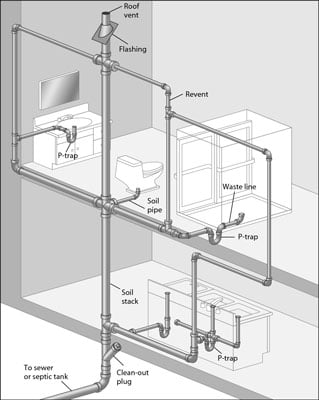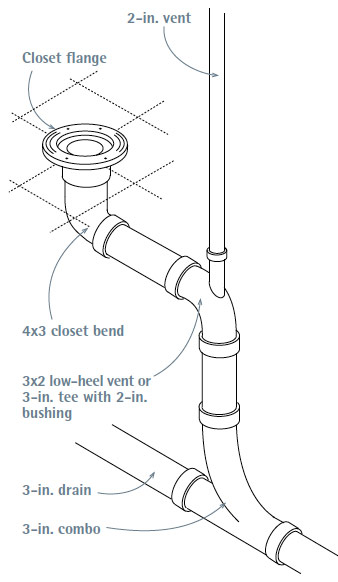Why Adequate Ventilation Matters in Plumbing Systems
Why Adequate Ventilation Matters in Plumbing Systems
Blog Article
We've discovered the article pertaining to What Are Plumbing Vents and Why Are They Important? directly below on the internet and felt it made good sense to share it with you on this page.

Proper air flow in plumbing systems is typically forgotten, yet it is important for preserving the performance and security of your home's plumbing. Ventilation aids manage air pressure, protect against the buildup of damaging gases, and make certain the effective removal of waste. In this guide, we will discover the value of appropriate plumbing ventilation, just how it works, and the advantages it gives your pipes system.
Understanding Air Flow in Pipes
Air flow in plumbing describes the network of pipes that allow air to stream with the drain system. These vents offer multiple functions, including controling atmospheric pressure within the pipelines, avoiding drain gases from going into the home, and aiding in the smooth flow of wastewater.
Just How Ventilation Functions in Pipes Systems
Atmospheric Pressure Guideline
Appropriate air flow keeps balanced atmospheric pressure within the plumbing system. When water streams through pipelines, it displaces air. Without appropriate ventilation, this variation can produce adverse pressure, causing slow drains or siphoning of water from catches, which can cause unpleasant odors to permeate into the home.
Avoiding Sewage System Gas Buildup
One of the most essential features of pipes vents is to prevent sewer gases, such as methane and hydrogen sulfide, from building up within the home. These gases can present major health threats and are highly combustible. Vent pipelines enable these gases to escape securely outside.
Assisting in Waste Removal
Air flow assists in the effective elimination of wastewater by stopping airlocks in the water drainage system. When air can flow easily through the vents, it permits water and waste to stream smoothly through the pipelines, reducing the threat of obstructions and backups.
Kinds Of Pipes Vents
Main Heap Vent
The main stack air vent, additionally known as the vent pile, is the key air vent in a pipes system. It prolongs from the primary drainpipe align through the roof covering, allowing gases to get away and fresh air to enter the system.
Branch Vent
Branch vents attach to the major pile air vent and serve individual components, such as sinks, bathrooms, and showers. These vents ensure that each fixture has ample ventilation to work correctly.
Air Admittance Shutoff (AAV).
An Air Admittance Shutoff (AAV) is a one-way valve that permits air to enter the pipes system without the need for a traditional air vent pipe expanding with the roof. AAVs are typically utilized in restorations or locations where mounting a typical air vent is impractical.
Signs of Poor Ventilation in Plumbing.
Slow Draining Fixtures.
If your sinks, bathtubs, or toilets are draining pipes slowly, maybe an indication of inadequate ventilation. Inadequate air flow can produce a vacuum cleaner effect, making it hard for water to drain pipes effectively.
Gurgling Sounds.
Gurgling audios originating from drains pipes are commonly a result of air being sucked through water catches due to adverse pressure in the pipes. This is a clear indicator of inadequate air flow.
Undesirable Odors.
Sewer odors inside your home are a warning that your plumbing system is not correctly ventilated. This could suggest that sewer gases are not being adequately aired vent outside, leading to potentially dangerous conditions.
Usual Ventilation Blunders.
Inadequate Vent Sizing.
Making use of undersized vent pipelines can bring about poor air flow and pressure inequalities in the system. It's important to make use of vents that meet the certain demands of your plumbing system.
Improper Vent Positioning.
Positioning vents as well far from the components they offer can reduce their effectiveness. Correct placement makes sure that air can move easily and effectively through the system.
Ignoring Code Needs.
Building ordinance offer particular standards for pipes air flow. Neglecting these codes can result in a system that stops working to operate correctly and may result in expensive repairs or carcinogen.
Advantages of Correct Ventilation.
Improved System Performance.
Correctly aerated pipes systems run more effectively, with less clogs, faster draining, and less strain on the pipelines. This performance expands the life-span of the pipes system.
Improved Air Top Quality.
By preventing sewer gases from entering your home, proper ventilation adds to far better interior air high quality, making your living atmosphere healthier and much more comfortable.
Preventing Water Damages.
Appropriate ventilation helps protect against water from being siphoned out of catches, which can cause sewer gases going into the home and creating water damage over time.
Actions to Make Certain Appropriate Air Flow.
Consulting Pipes Codes.
Constantly get in touch with local plumbing codes when developing or customizing your plumbing system. These codes give the necessary standards for appropriate airing vent and ensure your system satisfies safety and security standards.
Routine Inspection and Maintenance.
Routine assessments can aid identify prospective air flow concerns prior to they become major problems. Maintenance tasks, such as cleaning up air vent pipes and checking for blockages, are vital for maintaining the system in good working order.
Specialist Installation.
For new setups or significant modifications, it's smart to hire an expert plumbing professional. They have the proficiency to ensure the air flow system is properly made and mounted according to code.
Verdict.
Appropriate ventilation is a vital component of any plumbing system, making certain that it operates effectively and securely. By comprehending the importance of ventilation, recognizing the indications of inadequate air flow, and taking steps to preserve your system, you can protect against costly issues and secure your home's air top quality.
What is a Plumbing Vent and it's used for?All plumbing systems in residential and commercials construction have a plumbing vent. It doesn’t just vent unwanted odors from the drainage system to the outside; it actually serves an important purpose by supplying air to the system.
The plumbing drainage system is actually called a drainage, waste and vent (DWV) system. When water flows down the piping, an air supply (vent) is needed to allow the water to flow. Think of the vertical pipe as a drinking straw. If you plug the top end of a straw, liquid won’t drain from it.
The DWV system in your building consists of a series of pipes connected to each fixture; they extend above each fixture, and the system terminates at an open pipe that extends through the roof. This piping allows air into the system and prevents unbalanced pressures in the piping.
?The vent also prevents the system from drawing water out of a trap at the fixture with the characteristic “glug-glug-glug” as the drain gasps for air. Plumbing traps should drain smoothly and never “glug” or gasp for air.
If you have a drain that empties slowly or gurgles as it drains, this may indicate a venting problem. If you flush a toilet and the sink gurgles, there’s definitely a vent problem. It is good idea to have a Plumber check this.
https://www.ameliashomeinspection.com/blog/what-is-a-plumbing-vent-and-its-used-for

Do you really like more info about The Upsides of Proper Ventilation in Plumbing Design? Give feedback further down. We will be delighted to listen to your feelings about this article. In hopes that you come back again before long. Sharing is nice. Helping others is fun. Thank-you for taking the time to read it.
Contact Us Report this page